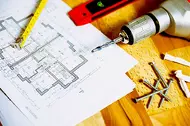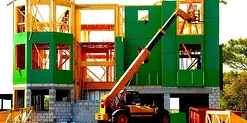Top Mistakes to Avoid When Building Your Home in New Zealand
 By
Trent Bradley
·
6 minute read
By
Trent Bradley
·
6 minute read

Building your dream home should be one of life's most rewarding experiences, but for many New Zealand families, poor planning and avoidable mistakes turn their building journey into a costly nightmare. Understanding the most common building mistakes NZ homeowners make can save you tens of thousands of dollars, months of delays, and unnecessary stress during what should be an exciting time.
The reality is that building a home involves dozens of complex decisions, tight coordination between multiple professionals, and careful management of budgets that can easily spiral out of control. Even small mistakes early in the process can compound into major problems that affect your timeline, budget, and final satisfaction with your new home.
With New Zealand's construction industry facing ongoing challenges from material cost volatility, labour shortages, and increasingly complex regulations, avoiding common pitfalls has become more critical than ever for successful project completion within budget and on schedule.
The High Cost of Building Mistakes
Before diving into specific mistakes, it's important to understand just how expensive building errors can become. A seemingly minor oversight in planning can result in thousands of dollars in additional costs, while major mistakes can add 20-30% or more to your total project budget.
Beyond financial costs, building mistakes create stress, delay move-in dates, strain relationships with builders and professionals, and can even affect your home's long-term value and functionality. The good news is that most building mistakes are entirely preventable with proper planning and professional guidance.
Budget and Financial Planning Mistakes
Underestimating Total Project Costs
The Mistake: Focusing only on the building contract price without accounting for all the additional costs required to complete your project and move in.
The Reality: Many builders discover their total investment is 20-40% higher than their initial building contract, with costs for land preparation, professional fees, temporary accommodation, landscaping, and unexpected variations quickly adding up.
Common Oversights:
- Council fees and development contributions
- Service connection costs for power, water, and telecommunications
- Site preparation and earthworks expenses
- Professional fees for architects, engineers, and surveyors
- Temporary accommodation during extended construction periods
- Insurance during construction and holding costs
Inadequate Contingency Planning
The Mistake: Failing to budget adequate contingencies for unexpected costs that inevitably arise during construction.
The Reality: Construction projects rarely proceed exactly as planned. Weather delays, site condition surprises, material price increases, or necessary design changes can quickly consume budgets without adequate contingency planning.
Best Practice: Budget at least 10-15% contingency for straightforward builds, and up to 20% for complex or challenging projects.
Poor Construction Loan Management
The Mistake: Not understanding how construction financing works or failing to coordinate loan drawdowns with construction progress and cash flow requirements.
The Reality: Construction loans require active management throughout the building process. Poor coordination can create cash flow problems, delay construction, or result in unnecessary interest costs.
Land Selection and Site Preparation Errors
Insufficient Due Diligence
The Mistake: Falling in love with a section without thoroughly investigating all factors that could affect building costs and outcomes.
Critical Oversights:
- Soil conditions requiring expensive foundation solutions
- Slope and drainage issues affecting building design and costs
- Access challenges increasing construction logistics costs
- Utility connection availability and costs
- Council zoning restrictions limiting building options
- Natural hazard risks affecting insurance and safety
Ignoring Future Development Plans
The Mistake: Choosing land without researching planned infrastructure, zoning changes, or developments that could affect your property's value and lifestyle.
The Impact: Your quiet rural outlook might become a major highway, or that empty section next door might become high-density housing, dramatically changing your property's character and value.
Design and Planning Mistakes
Rushing the Design Process
The Mistake: Hurrying through design decisions to start construction quickly, without fully considering how design choices affect functionality, costs, and long-term satisfaction.
Common Issues:
- Inadequate storage throughout the home
- Poor flow between living areas
- Insufficient natural light in key spaces
- Bathrooms that are too small or poorly positioned
- Kitchen layouts that don't suit family cooking patterns
- Lack of outdoor living integration
Failing to Plan for Future Needs
The Mistake: Designing only for current family circumstances without considering how needs might change over 10-20 years.
Consider Planning For:
- Family growth requiring additional bedrooms
- Aging parents who might need accessible accommodation
- Home office space for changing work patterns
- Teenager privacy and independence needs
- Reduced mobility requiring single-level living
Ignoring Orientation and Climate
The Mistake: Not considering how your home's orientation affects natural light, heating costs, and indoor comfort throughout the year.
The Impact: Poor orientation can result in cold, dark living areas, excessive summer heat, or significantly higher ongoing energy costs that compound over decades of ownership.
Builder and Contract Selection Errors
Choosing Based on Price Alone
The Mistake: Selecting the cheapest builder without thoroughly evaluating their experience, quality standards, financial stability, and ability to complete your project successfully.
Red Flags to Watch For:
- Quotes significantly below market rates
- Limited recent references or examples of completed work
- Poor communication or unprofessional presentation
- Pressure to sign contracts immediately
- Inadequate insurance or licensing
- Financial instability or cash flow problems
Inadequate Contract Review
The Mistake: Signing building contracts without thorough legal review or full understanding of terms, inclusions, and variation procedures.
Critical Contract Elements:
- Detailed specifications of included materials and finishes
- Clear variation and change management procedures
- Realistic completion timeframes with penalty clauses
- Payment schedules aligned with construction progress
- Warranty terms and dispute resolution procedures
- Professional indemnity and public liability insurance requirements
Poor Communication Expectations
The Mistake: Failing to establish clear communication protocols, progress reporting, and decision-making processes with your builder.
The Result: Misunderstandings, delays, cost overruns, and relationship breakdowns that can derail projects and create legal disputes.
Professional Team Assembly Mistakes
Inadequate Professional Coordination
The Mistake: Failing to assemble a coordinated professional team or not clearly defining roles and responsibilities between architects, builders, engineers, and other specialists.
Common Problems:
- Design conflicts between architect and engineer requirements
- Miscommunication between professionals causing delays
- Overlapping or missed responsibilities creating gaps
- Inconsistent quality standards between different trades
- Poor coordination of specialist consultants
Trying to Save Money in Wrong Places
The Mistake: Cutting costs on critical professional services like structural engineering, surveying, or legal review that provide essential project protection.
The Reality: Saving a few thousand dollars on professional fees can result in tens of thousands in additional costs when problems arise that proper professional input would have prevented.
Financing and Legal Mistakes
Inadequate Insurance Coverage
The Mistake: Failing to arrange appropriate insurance coverage during construction, or not understanding what risks are and aren't covered.
Critical Coverage Types:
- Contract works insurance covering construction in progress
- Public liability insurance protecting against third-party claims
- Professional indemnity coverage for consultants and specialists
- Personal property insurance for temporary accommodation
Not Understanding Legal Obligations
The Mistake: Failing to understand your legal responsibilities as a client, particularly regarding health and safety obligations on construction sites.
Key Obligations:
- Principal contractor duties under health and safety legislation
- Building consent compliance requirements
- Licensed Building Practitioner (LBP) documentation needs
- Warranty and defect liability understanding
Timeline and Scheduling Errors
Unrealistic Timeline Expectations
The Mistake: Expecting construction to proceed faster than realistic timeframes, leading to pressure for shortcuts, poor quality work, or relationship breakdowns.
Realistic Expectations:
- Simple builds: 6-9 months from consent to completion
- Complex builds: 12-18 months or more depending on design
- Weather delays can add 1-3 months to any timeline
- Consent processing can take 2-4 months before construction begins
Poor Coordination with Life Events
The Mistake: Not coordinating construction timelines with school starting dates, work commitments, lease expiry dates, or other life events that create deadline pressure.
Planning Considerations:
- School zone enrollment deadlines
- Lease renewal or termination dates
- Work relocation timing
- Family event scheduling
- Seasonal considerations for construction
Quality Control and Supervision Mistakes
Lack of Independent Quality Oversight
The Mistake: Assuming your builder's quality control is sufficient without independent verification of work standards and Building Code compliance.
The Reality: Even experienced builders can have different quality standards than your expectations. Independent oversight helps identify issues early when they're easier and less expensive to remedy.
Not Documenting Issues Promptly
The Mistake: Failing to document quality issues, variations, or problems promptly and formally, making resolution more difficult later.
Best Practices:
- Maintain detailed photo records of construction progress
- Document all meetings and decisions in writing
- Address quality concerns immediately rather than hoping they'll be fixed later
- Maintain organized records of all project communications
Regional Specific Mistakes
Auckland Urban Challenges
Common Mistakes:
- Underestimating council processing times and compliance costs
- Inadequate planning for site access and storage in tight urban sites
- Not researching neighbourhood development plans affecting property values
Wellington Topographical Issues
Common Mistakes:
- Inadequate geotechnical investigation before purchasing sloping sites
- Underestimating earthquake engineering requirements and costs
- Poor planning for wind exposure and weather protection
Canterbury Rebuild Lessons
Common Mistakes:
- Not learning from post-earthquake building improvements and requirements
- Inadequate attention to ground conditions and liquefaction risk
- Underestimating enhanced compliance requirements
Technology and Modern Building Considerations
Future-Proofing Oversights
The Mistake: Not considering how rapidly evolving technology affects home design and infrastructure requirements.
Planning Considerations:
- Electric vehicle charging infrastructure
- High-speed internet and smart home wiring
- Solar panel and battery system compatibility
- Modern heating and cooling system integration
Sustainability and Energy Efficiency
The Mistake: Not considering long-term operating costs and environmental impact when making design and material choices.
The Impact: Poor energy efficiency choices made during construction result in higher ongoing costs for decades and reduce property values as energy standards continue to rise.
Learning from Others' Mistakes
The building mistakes covered here represent thousands of dollars in unnecessary costs and months of delays experienced by New Zealand families who learned these lessons the hard way. The good news is that most building mistakes are entirely preventable with proper planning, professional guidance, and comprehensive understanding of the complete building process.
Successful builders invest time upfront in thorough planning, professional team assembly, and comprehensive risk management. They understand that building a home is a complex project requiring coordination of multiple specialists, careful financial management, and active oversight throughout construction.
While it's impossible to anticipate every challenge that might arise during construction, understanding common building mistakes NZ homeowners encounter helps you plan better, ask better questions, and make informed decisions that protect your investment and ensure project success.
The most successful building projects are those where families invest in comprehensive planning, professional guidance, and systematic approaches to managing the complex building process from initial concept through final completion.
If you're planning a building project and want to avoid the costly mistakes that derail so many construction dreams, contact Luminate Finance today. Our construction-to-permanent lending specialists have seen every type of building mistake and can help you develop comprehensive strategies that protect your investment while ensuring smooth project completion within budget and on schedule.
Ready to build your dream home without the costly mistakes that catch so many families off guard? Success requires more than just good intentions – it requires comprehensive planning and professional guidance. Contact Luminate Finance to discuss how our construction-to-permanent lending expertise includes helping you avoid the common pitfalls that can turn building dreams into costly nightmares.

Trent Bradley
Trent Bradley is a New Zealand financial advisor specializing in property-backed finance and investment consulting. With over 26 years of experience running his mortgage broking business, he has helped wholesale investors access high-yield property-backed loan opportunities. For the past 12 years, Trent has led Luminate Finance, a New Zealand finance company dedicated to connecting investors with secure property investment solutions.










